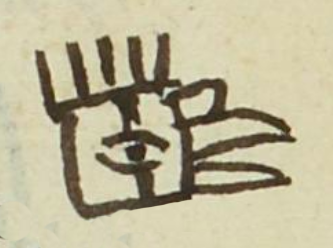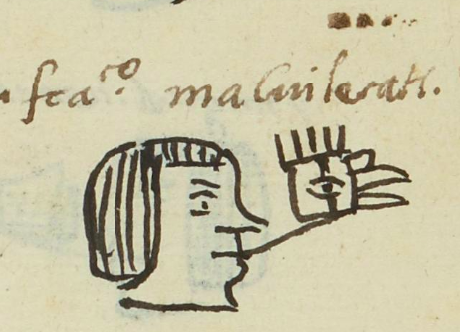Macuilecatl (MH576v)
This black-line drawing of the simplex glyph plus a notation for the personal name Macuilecatl (presumably, “Five-Wind,” attested here as a man’s name) shows a profile view of a mask (facing toward the viewer's right) that recalls the deity or divine force of the wind, Ehecatl. On the top of the mask are five, short, vertical lines representing the notation for the number five. Emblematic of Ehecatl is the blunt object above the beak-like mouth and the vertical face paint on the cheek. The beak is open, as is the visible eye.
Stephanie Wood
This is a calendrical name, a day sign in the 260-day divinatory calendar called the tonalpohualli, and calendrics are significant in the Nahuas' religious views of the cosmos. The person who bore the name was likely born on the day of 5-Wind. It is not unusual to have glosses that do not include the reduplication of the word for wind, ehecatl, but only the word for air or breath, ecatl. A great many glyphs in this collection start with Eca- when one might expect Eheca-. We are preserving the proclivity of the gloss for Eca-, while also pointing to the likelihood of an unintentional oral abbreviation of Eheca- to Eca-.
Gabrielle Vail and Christine Hernández (Re-Creating Primordial Time, 2013, ) describe Ehecatl as the wind aspect of Quetzalcoatl, and they note that Ehecatl "wears a buccal (duck) mask through which to blow wind." That the "beak" may have been perceived as a blowing device is supported by the glyph for Pitztli (below).
John Montgomery drew a group of wind glyphs (possibly mainly Mixtec), showing the variety of ways the blowing device might look. It is published in FAMSI, Inc.
1560
Jeff Haskett-Wood
viento, pájaros, wind, air, breath, aire, viento, aliento, soplar

macuil(li), five, https://nahuatl.wired-humanities.org/content/macuilli
eca(tl), air or breath, https://nahuatl.wired-humanities.org/content/ecatl
Ehecatl, wind or the divine force/spirit of wind, what some would call a deity, https://nahuatl.wired-humanities.org/content/ehecatl
Cinco Viento, o 5-Viento
Stephanie Wood
Matrícula de Huexotzinco, folio 576v, https://www.loc.gov/resource/gdcwdl.wdl_15282/?sp=232&st=image
This manuscript is hosted by the Library of Congress and the World Digital Library; used here with the Creative Commons, “Attribution-NonCommercial-ShareAlike 3.0 License” (CC-BY-NC-SAq 3.0).









